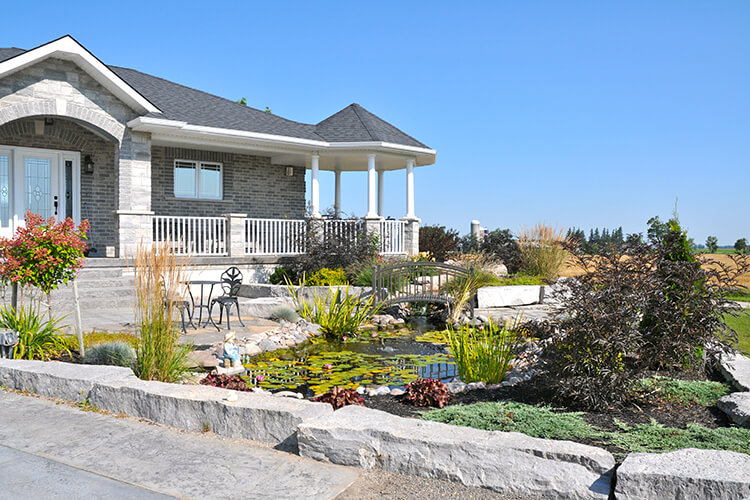Enhance the comfort and beauty of your yard with hardscaping
Hardscaping is probably not a term you use very often, but it’s actually a common facet of landscaping. In fact, you probably have some hardscaping elements in your yard.
The “hard” in hardscaping refers to the non-living or inanimate elements in a yard’s layout. In contrast, “softscaping” includes all living matter including plants and flowers, trees and shrubs, plus soil, mulch, and of course grass.
Natural stone, wood, gravel, concrete (precast and pour-in-place), interlocking brick, and composite are the most common hard materials used in the creation of fencing, retaining walls, waterfalls, ponds, patios, pathways, and more.
Standard inclusions in virtually any property are walkways, a driveway, decking, and fencing. However, many home owners opt to upgrade at some point, either to add new features to their existing landscape or simply to update outdated elements.
So how do you decide what features to add or change and which materials to use? When we consult with our clients, we consider several variables including specific goals, personal style, the style of the home and surroundings, and budget.
One of the primary goals that hardscaping can help address is added privacy. You can achieve this by adding a fence line or panels, a wall(s) or even just creating a privacy screen on one or both sides of your deck or patio. To soften the overall appearance, consider combining hardscaping elements with tall shrubs or ornamental grasses that can also enhance privacy.
Another common goal is expanding outdoor living space. Options here are dependent on available space and budget, and can range from a small deck to a multi-tiered patio with an entertainment area, bar, built-in kitchen, pool, pond, waterfall, and/or fire table with seating.
Natural stone retaining walls are a great solution for adding depth and visual interest, or dealing with a steeply graded yard or uneven grading around the perimeter. Armour stone is a popular choice for creating retaining walls as they are large, but natural and create visual impact.
Pathways to and around your home can add visual appeal and can also create visual separation and definition of gardens. Although poured concrete is the standard for walkways between the driveway and front entrance, explore other options like flagstone, interlocking brick, decorative pavers, or even materials generally relegated to the backyard like wood or composite.
If there are areas around your home where grass doesn’t thrive due to inadequate drainage or poor sun exposure, adding gravel and stepping stones can improve the appearance while also making navigation around those areas easier.
A couple caveats before you get started
- Even if you plan to add hardscaping in phases – say, the patio first, and then a pond and retaining walls over the next couple years – it’s best to create the whole plan at the outset so that you can be sure everything will work together when the entire project is completed. Short-term oversights can lead to long-term headaches.
- Think about drainage and environmental issues when adding immovable objects like a patio or a wall. Consider incorporating a means of collecting runoff water for use around your yard.
- Balance is best. You can create contrast with various sizes and shapes. Use two to three different complementary materials in your project. And most importantly, don’t overdo it with hard elements in your yard. Mix hardscaping with softscaping for best results.
- Ensure your design is appropriate for your lifestyle. If you have young children, maintaining an open, grassy area is probably a good idea. If you’re older and want a low-maintenance yard, you might opt for more hardscaping and drought-tolerant plants.
- Choose the right materials for your style. Whether your taste is modern, traditional, or somewhere in between, some materials are going to suit your style better than others, so choose carefully.
Hardscaping can add so much beauty to your yard and enjoyment to your outdoor living space. Just be sure to plan ahead for best results. Of course, sometimes it’s all just too daunting. A Touch of Dutch Landscaping and Garden Services can consult with you to create and implement a plan and design that meets your needs and fits your budget. Contact us to get started.

